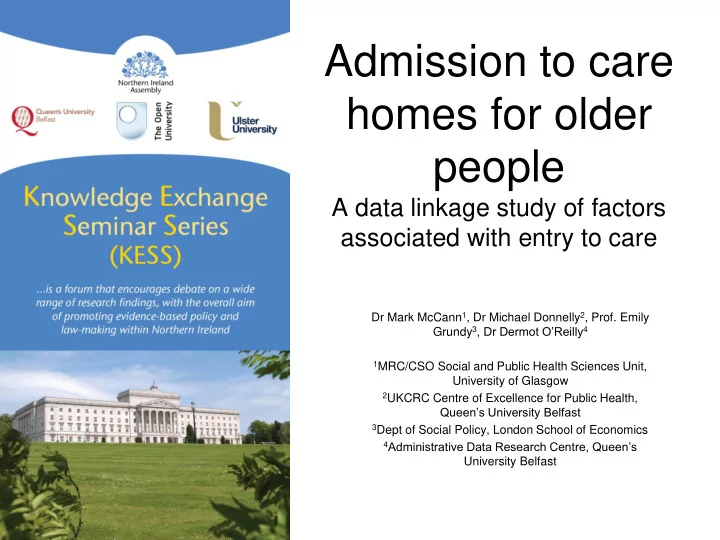

Admission to care homes for older people A data linkage study of factors associated with entry to care Dr Mark McCann 1 , Dr Michael Donnelly 2 , Prof. Emily Grundy 3 , Dr Dermot O’Reilly 4 1 MRC/CSO Social and Public Health Sciences Unit, University of Glasgow 2 UKCRC Centre of Excellence for Public Health, Queen’s University Belfast 3 Dept of Social Policy, London School of Economics 4 Administrative Data Research Centre, Queen’s University Belfast
The changing population • Life expectancy has steadily increased • Young people today can expect to live longer than ever before • Greater numbers will live into very old age • BUT......Age isn’t everything! • Greater proportion of childless people • Change in living arrangements • Smaller families • Two generation households, extended family less common • Economic upturns & downturns • Cumulative experience of inequality and poverty
Future population health • Social situation today Health situation tomorrow • Information about care home utilisation can • Give insight into the causes of current patterns • Provide clues as to ‘what works’ • Forecast the direction of travel for social causes • Health research as part of the toolkit for crafting policy
NILS linkages Health Card Registration Change of address - every six months General registrar’s office Deaths – at regular intervals 2001 Census forms Age, sex, health, house tenure, living arrangements Co-resident age, health
Additional linkages Regulation & Quality Improvement Authority Residential & Nursing homes Land & Property Services Rateable value of houses Geo-referencing Health & Social Care Trust Boundaries Multiple Deprivation Measures Delineation of Settlements
Settlements Health Card Register LPS Census Household Death records Urban/Rural House value Living arrangement Change of address Census 2001 2007 Care home addresses RQIA
The study cohort All NILS members 65 + years not in care 51,619 individuals Six year follow up from Census day 2,138 (4%) admitted Cox proportional hazard regression Time to admission as outcome Right censored at time of death or end of 6 years Several risk factors considered All research carried out in a “secure setting”
Living arrangements The importance of living with others versus living alone Specific issues: Living with family versus non family? One person, more than one person, many people? Broader question – what sort of households provide support?
Males Females Lives alone: 7% 7% Never married Widowed 11% 32% Separated 2% 3% Married 1% Lives with: Partner 50% 29% Partner & Children 17% 9% Partner & others 2% 4% Siblings 3% Children 4% 12% Others 3% 5%
4.5 4 3.5 3 2.5 2 1.5 1 0.5 0 M F M F M F M F M F M F M F M F M F Never married Widowed Separated Married Partner Partner and Partner and Siblings Children Others children others Lives alone: Lives with: MRC/CSO Social and Public Health Sciences Unit, University of Glasgow.
Housing tenure and value Wealth = health Wealth = greater purchasing power? Wealth = more unpaid care?
Self reported health by house tenure and value 80% 70% 60% 50% 40% 30% 20% 10% 0% Renting < £75k £75k to <£95k £95k to <£120k £120k to <£160k £160k or more Fairly/Not good health (% of group) LLTI (% of group)
1.1 Care home admission risk by house tenure and value Admission risk relative to ‘renting’ admission rate 1 0.9 0.8 0.7 0.6 0.5 Renting < £75k £75k to <£95k £95k to <£120k £120k to <£160k £160k or more
Urban and rural areas Different lifestyle and health experience Difference in family support Difference in community support
General Health by Area Type 100% 90% 80% 70% 60% Not good 50% Fair Good 40% 30% 20% 10% 0% Urban Intermediate Rural
Gender difference 45 Percentage in each living arrangement by area type 40 35 Urban 30 25 Intermediate 20 15 Rural 10 5 0
0.4 0.6 0.8 1.2 1.4 1.6 1 Urban Full Intermediate Rural Urban Relative risk of admission Males Intermediate Rural Urban Females Intermediate Rural
Findings & Implications Living arrangements Variation in support in the home more important than levels of support outside the home Spouses more supportive than siblings Living with children and spouse particularly supportive Current trends in family structure suggests less supportive environments for future generations Increase formal services or change household structures
Findings & Implications House ownership and value “We won’t pay with our homes” Greater caring burden for less affluent groups, knock on consequences for carers’ employment and health Financial crises - fewer deprived people (more often in poor health) will own their homes Future house values may not recoup care costs Funding sources other than housing: will be popular may well be necessary
Findings & Implications Urban and rural areas Different levels of health, different service needs More supportive household structures in rural areas Different family cultures? More space in rural houses? Less care home admission in rural areas Demand induced supply? Moves closer to home? Different deployment of formal home care? Can the rural experience be copied in urban areas?
Thank you for listening The help provided by the staff of the Northern Ireland Longitudinal Study (NILS) and the NILS Research Support Unit is acknowledged. The NILS is funded by the Health and Social Care Research and Development Division of the Public Health Agency (HSC R&D Division) and NISRA. The NILS-RSU is funded by the ESRC and the Northern Ireland Government. The authors alone are responsible for the interpretation of the data and any views or opinions presented are solely those of the author and do not necessarily represent those of NISRA/NILS. Many thanks to the staff at the Regulation and Quality Improvement Authority for their help with the care home data. Mark McCann holds a Medical Research Council (MRC)/University of Glasgow fellowship supported by MRC partnership grant MC/PC/13027. Twitter @Mark_McCann
Recommend
More recommend